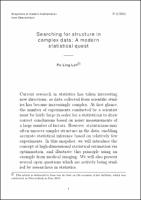| dc.contributor.author | Loh, Po-Ling | |
| dc.contributor.editor | Munday, Sara | |
| dc.contributor.editor | Bruschi, David Edward | |
| dc.contributor.editor | Jahns, Sophia | |
| dc.date.accessioned | 2021-03-29T13:00:02Z | |
| dc.date.available | 2021-03-29T13:00:02Z | |
| dc.date.issued | 2021-03-29 | |
| dc.identifier.uri | http://publications.mfo.de/handle/mfo/3851 | |
| dc.description.abstract | Current research in statistics has taken interesting
new directions, as data collected from scientific studies
has become increasingly complex. At first glance,
the number of experiments conducted by a scientist
must be fairly large in order for a statistician to draw
correct conclusions based on noisy measurements of
a large number of factors. However, statisticians may
often uncover simpler structure in the data, enabling
accurate statistical inference based on relatively few
experiments. In this snapshot, we will introduce the
concept of high-dimensional statistical estimation via
optimization, and illustrate this principle using an
example from medical imaging. We will also present
several open questions which are actively being studied
by researchers in statistics. | en_US |
| dc.language.iso | en | en_US |
| dc.publisher | Mathematisches Forschungsinstitut Oberwolfach | en_US |
| dc.relation.ispartofseries | Snapshots of modern mathematics from Oberwolfach;2021,03 | |
| dc.rights | Attribution-ShareAlike 4.0 International | * |
| dc.rights.uri | http://creativecommons.org/licenses/by-sa/4.0/ | * |
| dc.title | Searching for structure in complex data: a modern statistical quest | en_US |
| dc.type | Article | en_US |
| dc.identifier.doi | 10.14760/SNAP-2021-003-EN | |
| local.series.id | SNAP-2021-003-EN | en_US |
| local.subject.snapshot | Probability Theory and Statistics | en_US |
| dc.identifier.urn | urn:nbn:de:101:1-2021033011594828033348 | |
| dc.identifier.ppn | 1752959728 | |


